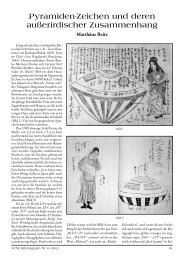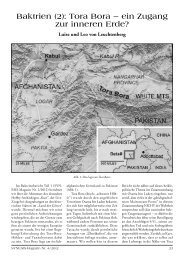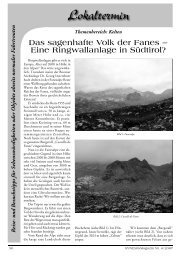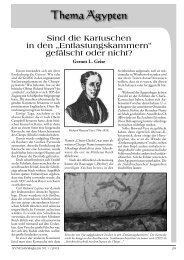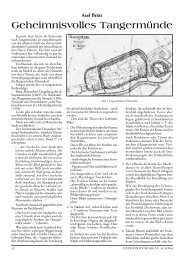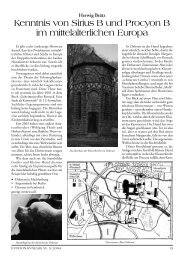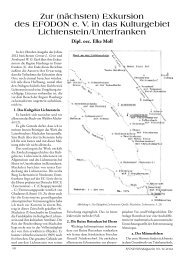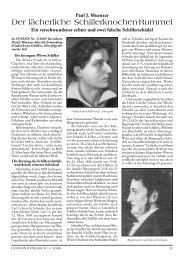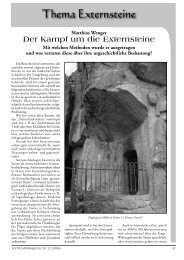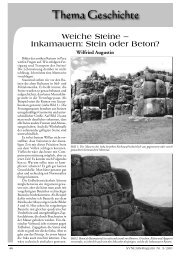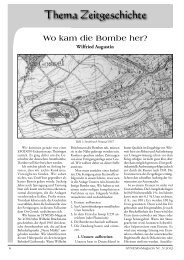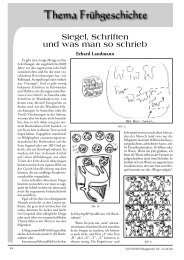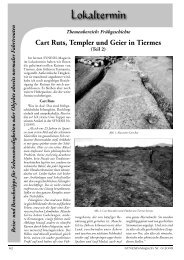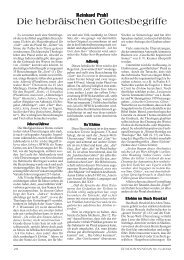Zum Ursprung des Horus-Glaubens im ... - EFODON eV
Zum Ursprung des Horus-Glaubens im ... - EFODON eV
Zum Ursprung des Horus-Glaubens im ... - EFODON eV
Erfolgreiche ePaper selbst erstellen
Machen Sie aus Ihren PDF Publikationen ein blätterbares Flipbook mit unserer einzigartigen Google optimierten e-Paper Software.
Diese "schützende Einfriedung" ist in vielen Kulturmythen präsent, und in<br />
vielfältige Formen symbolisch dargestellt ...in Ägypten z.B. als Aakhut. 33<br />
33 David Talbott, On Testing the Polar Configuration, schreibt:<br />
"Because the north celestial Pole is its pivot or center, it is the polar configuration....<br />
[Der nördliche H<strong>im</strong>melspol als Das Auge <strong>des</strong> H<strong>im</strong>mels]<br />
The Egyptian Book of the Dead reads: "I am the lord of the crown. I am in the Eye, my egg. . .My seat is on<br />
mythrone. I sit in ... the pupil of the Eye." ...<br />
[Der nördliche H<strong>im</strong>melspol als die Schützende Einfriedung, Stadt oder Tempel <strong>des</strong> H<strong>im</strong>mels]<br />
"[T]he Hebrew celestial Jerusalem, "Subl<strong>im</strong>e in elevation in the uttermost north. . .the City of the King; the<br />
Chinese "Imperial City," defined as an enclosure around the north celestial Pole; the Hindu celestial city of<br />
Brahma, "the all-containing city" at the celestial Pole.... To the Egyptians, the celestial enclosure possessed<br />
the magical quality of protecting the inhabitants from the dark and chaotic forces outside the enclosure, and<br />
this s<strong>im</strong>ple fact will explain why the enclosure was conceived as a shield.....<br />
[Der nördliche H<strong>im</strong>melspol als Säule oder Berg]....<br />
The Hindus knew the famous mountain as Meru, on whose summit stood the pr<strong>im</strong>eval dwelling of the gods. In<br />
the beginning this "golden mountain" or "jewelled peak" rose in the cosmic sea to serve as a universe pillar<br />
holding aloft the celestial city of Brahma. Around the summit of this axis-mountain turned the starry heavens.<br />
Chinese myth recalls a s<strong>im</strong>ilar mount.... On the summit of Kwen-Lun stood the great palace of Shang-ti, the<br />
universal emperor at the celestial Pole ... Tze-wei, "a celestial space around the north Pole."<br />
The Japanese recalled the world mountain Shumi, <strong>des</strong>cribed as "a fabulous mountain of wonderful height,<br />
forming the axis of every Universe, and the center around which all the heavenly bodies revolve." ...<br />
According to the Zend Avesta, "The Maker Ahura Mazda has built up a dwelling on the Hera-Berezaiti, the<br />
bright mountain around which the many stars revolve....<br />
Altaic races remember the cosmic mountain whose "peak rises to the sky at the North Star where the axis of<br />
the sky is situated, and where, on the peak, the dwelling of the Over-god and his 'golden throne' are situated."<br />
This was "at the navel of heaven, on the peak of the famous mountain."<br />
The Greek Olympos, where stood the original city of the gods and home of Kronos ... was the "wholly shining,"<br />
a cosmic mountain rising intothe fiery aether and called the "navel" and "axis" of the world.<br />
The Hebrew celestial Jerusalem stood on the summit of the cosmic Zion, after which the Hebrews named the<br />
local hill in Palestine. "Great is the Lord, and greatly to be praised in the city of our God, in the mountain of his<br />
holiness. Beautiful for situation, the joy of the whole earth, is mount Zion." "Mt. Zion, thou 'far reaches of the<br />
North,' an emperor's citadel."<br />
Many remarkable counterparts to these traditions will be found in the myths and symbols of the New World.<br />
One of the better known instances is the White or Shining Mountain Colhuacan, recognized by many writers as<br />
a polar column. On the summit of Colhuacan dwelt the original divine race.<br />
The Omaha recall... "the great white rock, standing and reaching as high as the heavens, enwrapped in mist,<br />
verily as high as the heavens."<br />
In the Esk<strong>im</strong>o tradition the world of the gods is situated above a great mountain around which the celestial<br />
bodies revolve.<br />
[Der Pol als Berg, Säule, Pfosten, Phallus, Schlange, Weltenbaum, Vogel]<br />
The hypothesized cosmic mountain could hardly have failed to produce a great variety of symbols.... Taking the<br />
most obvious examples, we list these mythical <strong>im</strong>ages as the logical and predicted figures of the cosmic<br />
column, if such a thing was actually witnessed by ancient man: World Mountain, Pillar, Binding Post, Phallic<br />
Column, Serpent-Column, Trunk of the World Tree ....<br />
Egyptian symbolism presents the four life-bearing streams as the Four Sons of <strong>Horus</strong>, identified as "four<br />
blustering winds," "four blazing flames" or fourstreams of water. But the same figures are presented as "four<br />
pillars of heaven" placed at the four corners of the celestial habitation.... [T]he outstretched wings of the<br />
thunderbird or winged god or god<strong>des</strong>s, signified the same thing as the cosmic ship, the two peaks of the world<br />
mountain .... The stationary god rests within the band of the Aten (presented in its popular form as a circular<br />
serpent). Within the enclosure the god's seat is the Aakhut, the two-peaks of the Mountain of Fire-Light."<br />
Ich halte Talbott's Hauptthese allerdings für absolut falsch, aber seine Diskussion über<br />
alte Pol-Mythologien ist ausgezeichnet. Siehe<br />
.<br />
13



